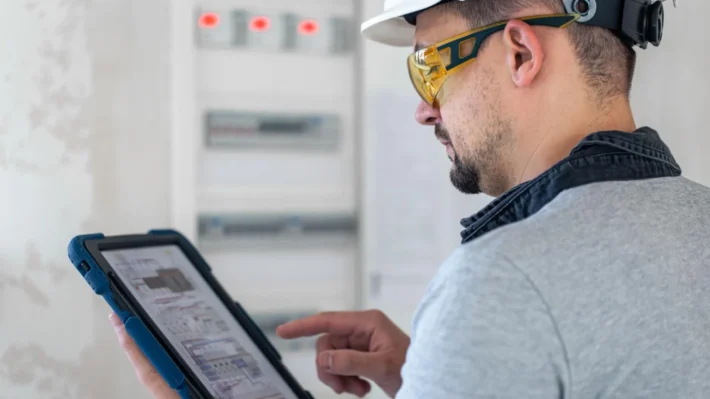Key Field Service KPIs in 2025: Benchmarks & Best Practices

To run a modern field service operation, be it construction, HVAC, plumbing, electrician services or property maintenance, an intense attention to measured performance is needed. Tighter profit margins, higher customer expectations, and the emergence of AI, IoT, and mobile technologies in 2025 make it important to monitor the appropriate Key Performance Indicators (KPIs). In this guide, the most significant field service KPIs in 2025 are described, supported by industry standards and best practice considerations, including how such platforms as Jobcamp can assist in monitoring and optimizing these key performance indicators.
The Significance of KPIs and the 2025 Changes
The way field service is performed has changed tremendously. Paper job tickets and manual dispatching are becoming a thing of the past. Instead, they have smart systems, which utilize AI-driven triage, on-demand mobile applications, predictive maintenance through the IoT, and self-service customer portals. These tools can not only enhance the job results but also increase the level across such performance indicators as first-time fix rate, mean time to repair, and technician utilization rate.
Modern customers require almost instantaneous service updates, transparency, and quick outcomes. These will be possible by ensuring that your internal teams are all aligned towards clear and data-driven objectives- and using software such as Jobcamp to monitor, report, and take action on these objectives regularly.
Basic KPIs & New 2025 Benchmarks
First-Time Fix Rate (FTFR)
- Definition: The FTFR is used to gauge the proportion of jobs done right the first time.
- 2025 Benchmark: By 2025, target teams are looking at an 80-90 percent range, and high achievers should get to 87-90 percent.
- Importance: Elevated FTFR minimizes re-dispatch, instills customer confidence, and enhances labor productivity.
- Technology’s Role: Mobile access to repair guides, precise parts tracking, and remote diagnostic tools are key enablers.
Mean Time to Repair (MTTR)
- Definition: MTTR indicates the time required to clear a job upon arrival.
- 2025 Benchmark: By 2025, the best service providers are averaging less than 5 hours, with many in HVAC and emergency service segments driving harder toward the 3-4 hour mark.
- Importance: Teams minimize labor and rental expenses, boost customer satisfaction by decreasing MTTR.
- Technology’s Role: AI-based diagnostics and pre-filled repair procedures are technology accelerators.
Mean Response Time
- Definition: This KPI measures the time taken between job request and dispatch.
- 2025 Benchmark: The 2025 standard is under 24 hours in case of routine service and 2-4 hours is optimal in case of critical jobs.
- Importance: Faster response time concrete service level agreements and brand reputation.
- Technology’s Role: These marks are struck with the aid of dynamic scheduling, self-service booking, and automated job routing.
Mean Travel Time
- Definition: Travel time influences cost and efficiency.
- 2025 Benchmark: The average travel is to be maintained below 30 minutes.
- Importance: Cutting-edge routing algorithms and real-time traffic information allow teams to stay efficient whilst minimising fuel costs, fleet wear and environmental harm.
Technician Utilization Rate (TUR)
- Definition: Utilization is the ratio of the time a technician spends on productive, billable activities.
- 2025 Benchmark: The target benchmark of 2025 is 70-80%.
- Importance: The monitoring of buried administration work, travel and idle time can help organizations pinpoint productivity log jams.
- Technology’s Role: Utilization can be enhanced by 5-10 percentage points through smart scheduling and automation compared to traditional scheduling.
Mean Cost per Service
- Definition: This KPI is a composite measure of labor, parts, travel, and administrative expenses that shows the overall cost of any job.
- Importance: The targets also differ by type of service- asset intensive businesses such as HVAC will accept higher limits. Nevertheless, FTFR, MTTR and travel time reduction contain costs.
- Technology’s Role: Back-office analytics lets teams make predictions and make pricing decisions based on cost trends.
Customer Satisfaction (CSAT & NPS)
- Definition: The satisfaction of the customer is ultimate. CSAT measures immediate satisfaction with an interaction (typically 1-5 scale), while NPS gauges overall loyalty and likelihood to recommend (0-10 scale).
- 2025 Benchmark: In 2025, a CSAT of 4.5 or above (out of 5) and an NPS of +40 or more will be regarded as outstanding.
- Importance: By combining customer feedback and operational KPIs, it becomes possible to see how service performance translates into customer perceptions- and what really matters to the clients can be more readily discovered.
The Ideal Habits of KPI Monitoring in 2025
1. Create Relatable, SMART Goals.
Start with internal historical analysis and compare to 2025 benchmarks:
- FTFR: 80% or above.
- MTTR: 5 hours or less
- Travel Time: less than 30 minutes
- Utilization: 70–80%
- CSAT: 4.5-5/5
Analytics tools in Jobcamp enable you to track team and individual performance, and scale goals up or down depending on the season or type of project.
2. Apply Real-Time Dashboards
Live dashboards facilitate openness and velocity. Put performance measures where both the support staff and field technicians can see them. Communicate important progress in daily or weekly stand-ups. Install alerts when metrics reduce, to take corrective action immediately. Jobcamp and other platforms provide a personalized dashboard based on service verticals.
3. Integrate Quantitative and Qualitative Insights
Numbers can give you the what–customer feedback can tell you the why. Integrate post-job surveys into your processes and connect them to an outcome, such as MTTR or FTFR. Use text analytics to identify common themes (e.g., late arrival, fixed on first visit). During training, share results to enforce strengths or improve weaknesses.
4. Implement Root Cause Analysis as Soon as Possible
When KPIs reduce, take action straight away:
- Is MTTR trending because of parts shortage, skill gaps, or bad routing?
- Look at high and low performers to identify best practices or training requirements.
- Use those insights to fuel procedural change or training efforts.
5. Use Technology to Achieve your Goals.
The appropriate tools can make the KPI theory come to life:
- AI & Machine Learning: Automatic triage, job assignment, diagnostics, and optimization of dispatch.
- IoT-Based Maintenance: Anticipate problems before a system fails and eliminate repeat trips and MTTR.
- Mobile & Digital Tools: Remove the delays of paperwork and enable live job notes with photo attachments.
- Customer Self-Service: Deflect routine requests to portals to free up dispatch capacity and enhance satisfaction.
Conclusion: Remaining KPI‑Ready After 2025
Although KPIs, including FTFR, MTTR, response and travel time, utilization, and CSAT are essential, they are not immutable. Benchmarks have to shift with the interaction of emerging technologies, customer expectations and operational realities. Establish KPI tracking as a regular feature of reviews and customer feedback loops. Next, support them with AI, IoT, automation and real-time dashboards to transform data into action.
Whether you lead a field service team in construction, HVAC, plumbing, or any other trade, it is no longer sufficient to learn how to handle KPIs, as they have become the structure upon which high-quality performance, cost management, and customer loyalty are built in the long term. Then, with set goals, continuous research, and the assistance of the latest technologies, such as Jobcamp, your team will be able to reach the standards of 2025 and further consistently… and even surpass them.



